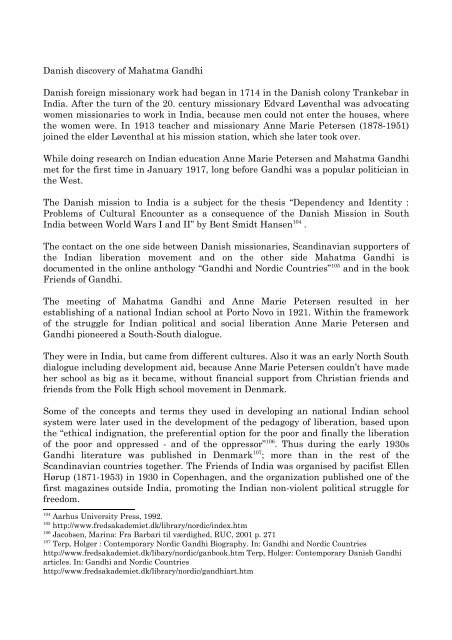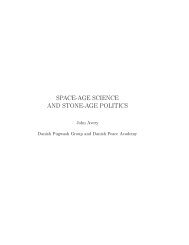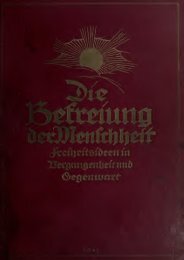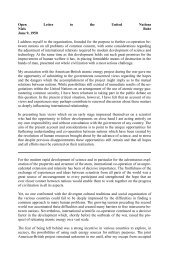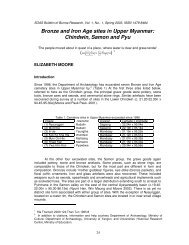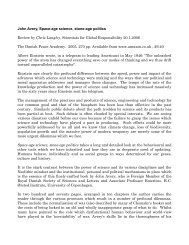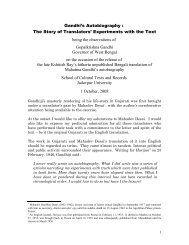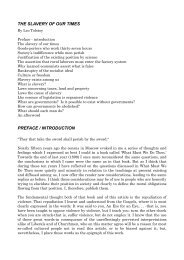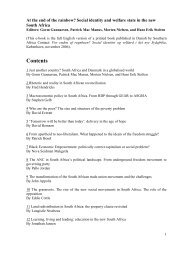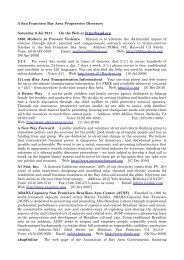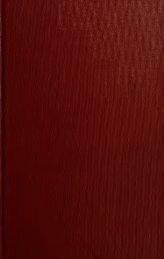Terp, Holger: Danish Peace History - Det danske Fredsakademi
Terp, Holger: Danish Peace History - Det danske Fredsakademi
Terp, Holger: Danish Peace History - Det danske Fredsakademi
You also want an ePaper? Increase the reach of your titles
YUMPU automatically turns print PDFs into web optimized ePapers that Google loves.
<strong>Danish</strong> discovery of Mahatma Gandhi<br />
<strong>Danish</strong> foreign missionary work had began in 1714 in the <strong>Danish</strong> colony Trankebar in<br />
India. After the turn of the 20. century missionary Edvard Løventhal was advocating<br />
women missionaries to work in India, because men could not enter the houses, where<br />
the women were. In 1913 teacher and missionary Anne Marie Petersen (1878-1951)<br />
joined the elder Løventhal at his mission station, which she later took over.<br />
While doing research on Indian education Anne Marie Petersen and Mahatma Gandhi<br />
met for the first time in January 1917, long before Gandhi was a popular politician in<br />
the West.<br />
The <strong>Danish</strong> mission to India is a subject for the thesis “Dependency and Identity :<br />
Problems of Cultural Encounter as a consequence of the <strong>Danish</strong> Mission in South<br />
India between World Wars I and II” by Bent Smidt Hansen 104 .<br />
The contact on the one side between <strong>Danish</strong> missionaries, Scandinavian supporters of<br />
the Indian liberation movement and on the other side Mahatma Gandhi is<br />
documented in the online anthology “Gandhi and Nordic Countries” 105 and in the book<br />
Friends of Gandhi.<br />
The meeting of Mahatma Gandhi and Anne Marie Petersen resulted in her<br />
establishing of a national Indian school at Porto Novo in 1921. Within the framework<br />
of the struggle for Indian political and social liberation Anne Marie Petersen and<br />
Gandhi pioneered a South-South dialogue.<br />
They were in India, but came from different cultures. Also it was an early North South<br />
dialogue including development aid, because Anne Marie Petersen couldn’t have made<br />
her school as big as it became, without financial support from Christian friends and<br />
friends from the Folk High school movement in Denmark.<br />
Some of the concepts and terms they used in developing an national Indian school<br />
system were later used in the development of the pedagogy of liberation, based upon<br />
the “ethical indignation, the preferential option for the poor and finally the liberation<br />
of the poor and oppressed - and of the oppressor” 106 . Thus during the early 1930s<br />
Gandhi literature was published in Denmark 107 ; more than in the rest of the<br />
Scandinavian countries together. The Friends of India was organised by pacifist Ellen<br />
Hørup (1871-1953) in 1930 in Copenhagen, and the organization published one of the<br />
first magazines outside India, promoting the Indian non-violent political struggle for<br />
freedom.<br />
104 Aarhus University Press, 1992.<br />
105 http://www.fredsakademiet.dk/library/nordic/index.htm<br />
106 Jacobsen, Marina: Fra Barbari til værdighed, RUC, 2001 p. 271<br />
107 <strong>Terp</strong>, <strong>Holger</strong> : Contemporary Nordic Gandhi Biography. In: Gandhi and Nordic Countries<br />
http://www.fredsakademiet.dk/libary/nordic/ganbook.htm <strong>Terp</strong>, <strong>Holger</strong>: Contemporary <strong>Danish</strong> Gandhi<br />
articles. In: Gandhi and Nordic Countries<br />
http://www.fredsakademiet.dk/library/nordic/gandhiart.htm


